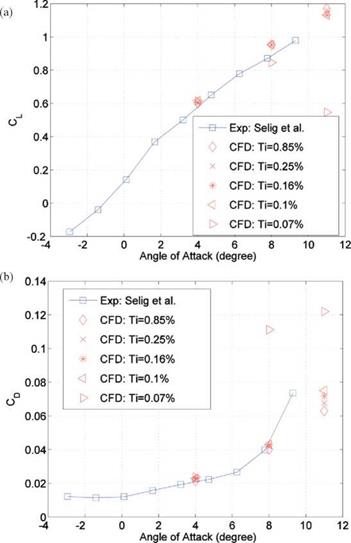Effect of Free-Stream Turbulence
When both the AoA and chord Reynolds number are fixed, increasing the free – stream turbulence level prompts an earlier transition. The aerodynamic characteristics under different turbulence intensities were investigated by Lian and Shyy [117]. The lift and drag coefficients from their research are shown in Figure 2.27. At the AoA = 4°, there is no noticeable difference in the lift and drag coefficients among the five tested turbulence levels. This seemingly contradicts the pressure coefficient plot in Figure 2.28 because the integrated area between CP = 0 and CP distributio
At the AoA = 8°, there is a drastic decrease in the lift coefficient and an increase in the drag coefficient when Ti decreases to 0.07 percent. Analysis of the flow structure reveals that, at such a low-turbulence level, the flow fails to reattach after its initial separation. This separation bubble causes the lift coefficient to drop by 10 percent and the drag coefficient to increase by more than 150 percent. Similar conclusions can also be drawn for the case of AoA of 11°.
In general, with the increase in the free-stream turbulence level, the LSB becomes thinner and shorter. This is clearly shown in Figure 2.29. From the same figure it can also be seen that the shear stress decreases with the turbulence level. Because of the viscous effect, the boundary layer and the LSB change the effective shape of the airfoil. As shown in Figure 2.30, the free-stream with a higher turbulence level results in a relatively thinner effective airfoil than that with a lower turbulence level.
O’Meara and Mueller [150] experimentally studied the effects of free-stream turbulence on the separation bubble characteristics of a NACA 663-018 airfoil. They reported that, as the disturbance level is increased, the bubble is reduced in
![]()
|
|
|
|
|
|
|
|
|
|
 |
|
|
|
|
|
|
|
 |
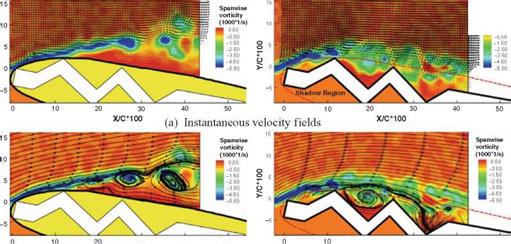


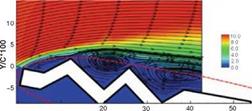


![]()
|
Figure 2.27. Lift and drag coefficients against the AoA at different turbulence levels for an SD7003 airfoil at the Reynolds number, Re = 6 x 104: (a) lift coefficient; (b) drag coefficient [117]. |
both length and thickness, which is consistent with the observations from Figures 2.29 and 2.30. As we discuss later, the effects of increasing the disturbance level resemble the effects of increasing the chord Reynolds number. O’Meara and Mueller [150] also reported that the suction peak grows in absolute magnitude with the disturbance level. However, as shown in Figure 2.28, the pressure peak over the SD7003 airfoil is not sensitive to the disturbance level. These two conclusions are drawn based on different test cases, in which the bubble size and Reynolds number are quite different. The results in Figure 2.31 are obtained at a chord Reynolds number of 1.4×105; occupying around 7 percent of chord length, the bubble is short and, as previously discussed, only locally affects the pressure distribution. In contrast, in
the test of Lian and Shyy [117], the bubble covers more than 30 percent of the upper surface at the Reynolds number of 6 x 104 and the AoA = 4°, and the bubble falls into the long-bubble category. This hypothesis is further confirmed by the fact that, at the Reynolds number of 6 x 104 and the AoA = 8°, wherein the bubble is 8 percent of the chord, the pressure peak magnitude does increase with the increase in the disturbance level.
![]()
![]()
![]()
![]()
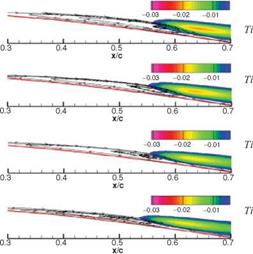
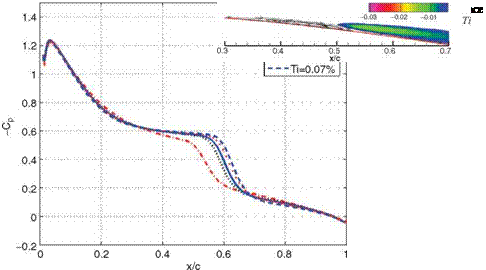 |
Figure 2.29. Streamlines and normalized shear-stress contours at the AoA = 4° for different turbulence levels for an SD7003 airfoil at the Reynolds number, Re = 6 x 104 [117].
![Подпись: Figure 2.30. Effective airfoil shapes at different turbulence levels for an SD7003 airfoil at the Reynolds number, Re = 6 x 104 [117].](/img/3131/image168_5.gif) |
Mueller et al. [151] presented the effects of free-stream turbulence on lift and drag performances of a Lissaman 7769 airfoil. As shown in Figure 2.32, the hysteresis characteristics of the lift and the drag coefficients can be observed for the free – stream disturbance intensity of around 0.10 percent. The hysteresis loop, however, disappears as the free-stream turbulence intensity is increased to 0.30 percent. They suggested that the surface roughness can also produce the same result. Furthermore, the disappearance of the hysteresis loop for aerodynamic lift and drag coefficients at high free-stream turbulence intensity seems to be related to the change in flow structure.











